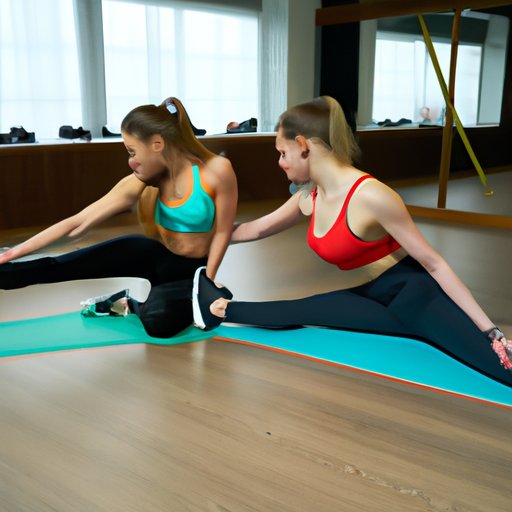
Introduction
The splits are a popular and impressive yoga pose that requires a great deal of flexibility and strength. While it may seem daunting, with proper technique, warm-up, and some patience, anyone can learn to do the splits. This article will provide tips and advice for those who want to increase their flexibility and learn how to do the splits.
Start with Proper Warm-up
Before attempting any advanced stretches like the splits, it is essential to warm up properly. Stretching cold muscles can lead to injuries or strains, so be sure to get your blood flowing and warm up before attempting the splits.
Before starting, it’s important to get your heart rate up with some cardio exercises like jumping or running in place. Next, start with some dynamic stretches that increase flexibility and mobility. Some examples of dynamic stretches you can do include:
- Butt kicks
- High knees
- Leg swings
- Knee-to-chest stretches
After dynamic stretches, move on to some mobility exercises that help increase flexibility and range of motion. Examples of mobility exercises include:
- Windmills
- Arm circles
- Side lunges
- Leg raises
Use Props
Another way to ease into the splits is by using props such as a yoga block, bolster, or pillow. These props can provide support and help ease you into the pose without putting too much strain on your muscles. Here’s how to use props to ease into the splits pose:
- Place the yoga block or bolster in front of you and prepare to step forward
- Step one foot forward, keeping the other foot behind you
- Place the block or bolster underneath your front thigh to provide support
- Sink into the pose slowly and hold it for a few breaths
- Repeat with the other leg in front
There are several types of props you can use to support your body as you work towards the full splits. These include blankets, bolsters, pillows, and yoga blocks. Choose the prop that works best for you and your level of flexibility.
Gradual Progression
It’s important to emphasize that splits are not a one-day job. Starting with basic stretches will help you prepare your body for full splits. You can try stretches like the forward fold or lunges to gradually increase your flexibility and work towards the full splits pose. Here are some variations of split poses that can help you achieve the full splits:
- Low-Lunge
- Runner’s Lunge
- Half-Splits
- Full Splits
Consistency Is Key
If you’re determined to learn how to do the splits, consistency is key. Make it a daily or weekly practice to work on your flexibility and incorporate splits into your routine. To stay motivated, set goals and track your progress, and reward yourself for milestones you achieve along the way.
Find a buddy to practice with and hold each other accountable. You can also take pictures to see how far you’ve come. Over time, you’ll begin to see improvement, and it will help keep you motivated to continue working towards your goal.
Avoid Over-Stretching
While it’s essential to stretch to increase flexibility and mobility, it’s vital to avoid over-stretching. Stretching too far too fast can lead to muscle strains or injuries. Know when to stop stretching and listen to your body. If you experience pain or discomfort, back off and take a break.
Stretch slowly, modify the stretches when needed. Use the props mentioned in section II and slowly increase the stretch to ensure you don’t overdo it. Stretching every day and holding a pose for an extended amount of time can do more harm than good.
Patience Is Important
Patience is vital while learning to do the splits. It takes time, consistency, and patience to achieve full splits, so don’t get frustrated if you don’t see progress right away.
It takes commitment, persistence, and lots of stretching to get there. It’s essential to set realistic expectations, celebrate small wins and trust the journey. With time and hard work, you’ll get there, and in the process, you’ll improve your flexibility and mobility.
Alternative Stretches for Not-Flexible People
Not everyone is flexible, and some people might require additional stretches to help prepare their body for the splits. There are a few alternative stretches that can help you work on tight hips and hamstrings. These include:
- Butterfly stretch sit on the floor with your knees bent and feet touching, and let your knees fall out wide to the sides. Sit up tall and hold for 30 seconds to 1 minute.
- Single Leg Seated Forward Fold – Sit with your legs straight in front of you. Reach toward your toes on your left foot, fold into your leg and attempt to place your head on your shin. Repeat on the other side.
- Pigeon Pose – From a downward-facing dog position, bring your right knee forward, placing it behind your right wrist. Extend your left leg behind you. Square your hips by drawing your left hip forward and your right hip back. Fold forward and hold. Repeat on the other side.
Remember to adjust these stretches according to your level of flexibility and not push too hard. Modify them by using props or holding for shorter periods.
Conclusion
The key to successfully learning how to do the splits is patience, persistence, and a consistent practice. Start by warming up properly and using props to support your body during the pose. Gradually work towards the full splits pose by incrementally increasing your flexibility through various poses and modifications. Stay motivated, and remember that progress will take time, so don’t get discouraged. With time and effort, you can achieve your goal of full splits.




